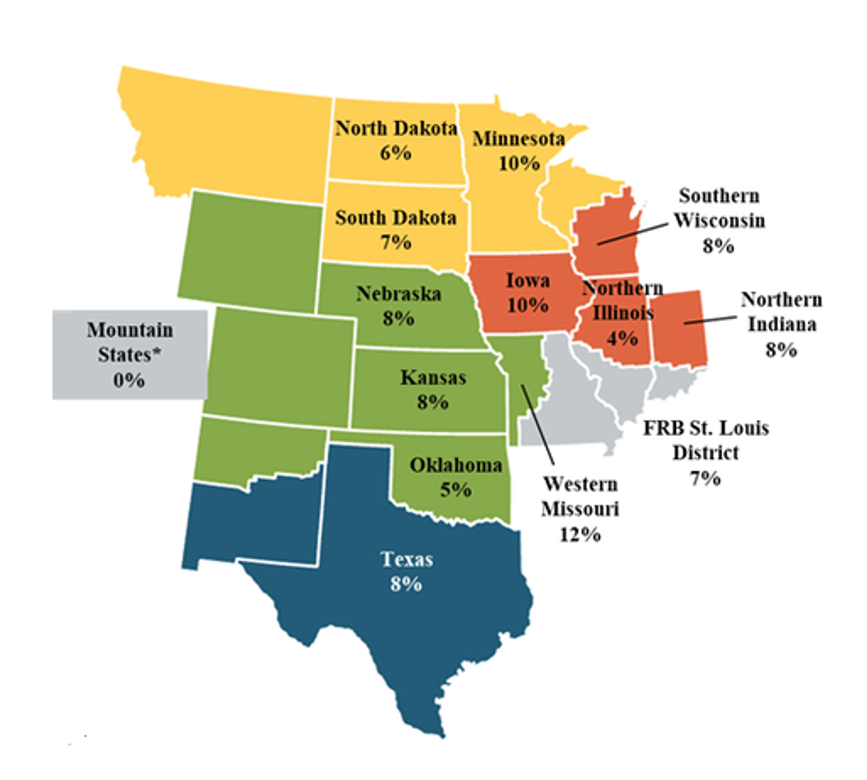Recent findings from the Federal Reserve Bank of Kansas City found nonirrigated cropland values in the central Plains rose, on average, 5 to 10% for first quarter 2021 compared to the prior year (Figure 1). Land values for nonirrigated cropland in mountain states remained unchanged from the prior year due to severe drought issues (Kauffman & Kreitman, 2021). Factors leading to increased cropland real estate values across the central Plains states include higher commodity prices, COVID-19 disaster assistance and low interest rates for long-term debt. Navigating these economic forces poses unique opportunities and challenges for agricultural operators across the United States.
Global trade patterns and concern for drought conditions across major grain-producing regions of the U.S. have led to historically high prices for corn, soybeans and wheat. Many of these commodities have not experienced comparable price levels since the drought of 2012. Farmers with any unpriced crop from 2020 received an opportunity to sell their production at higher price levels with the run-up in prices. Producers also anticipate favorable prices for the fall of 2021, but face production shortfall concerns due to drought. Higher farm income creates a bullish environment for acquiring additional cropland.
Different forms of disaster assistance during the COVID-19 pandemic improved the liquidity of many farm and ranch operations. Programs such as the Coronavirus Food Assistance Program (CFAP) or the Paycheck Protection Program (PPP) were implemented due to the disruption in supply chains and adversely affecting prices. Easing the pressure on farm liquidity and working capital have led to higher prices in other asset markets such as agricultural equipment. Improved farm finances, higher steel prices and the rise of online auctions were noted as major factors contributing to near record prices for new and used equipment (Peterson, 2021).
Interest rates for loans also impact the prices of agricultural land and equipment. The average fixed interest rates for operating, intermediate and long-term debt ranged from 4 to 5.5% for the central Plains states, according to the Federal Reserve bank of Kansas City (Kauffman & Kreitman, 2021). These rates allow operations to acquire long-term debt when purchasing land at favorable rates and capitalize them into the investment. For example, advertisements for a 30-year agricultural loan to a qualified borrower may be less than 4% for a fixed annual interest rate (FBN, 2021). Land market participants account for these rates when evaluating loan amortizations for making a new purchase.
Despite higher commodity prices and disaster assistance, farm and ranch operators face a high degree of uncertainty in 2021. Drought poses a major challenge for nonirrigated crop and livestock producers. Livestock prices also face high feed costs and significant drought in major ranching areas of the U.S. (Fuchs & Sanchez-Lugo, 2021). Prices for livestock have not trended up proportionally with corn and soybeans. Making prudent management decisions for the acquisition of land or other capital assets remains essential for the future growth and longevity of farms and ranches.
Jim Jansen, (402) 261-7572
Agricultural Economist
University of Nebraska-Lincoln
jjansen4@unl.edu
Jeff Stokes, (402) 472-2127
Hanson-Clegg-Allen Endowed Chair
Agricultural Banking and Finance
University of Nebraska-Lincoln
jeffrey.stokes@unl.edu
References
FBN. (2021, June 4). How Much Could You Save On Your Farmland Loan? Retrieved June 7, 2021, from Farmers Business Network: https://use.fbn.com/calculate-your-farmland-savings.
Fuchs, B., & Sanchez-Lugo, A. (2021, June 3). U.S. Drought Monitor. Retrieved June 4, 2021, from the National Drought Mitigation Center, University of Nebraska-Lincoln: https://droughtmonitor.unl.edu/.
Kauffman, N., & Kreitman, T. (2021, May 27). Regional Improvements in Farm Credit Conditions. Retrieved June 4, 2021, from the Federal Reserve Bank of Kansas City: https://www.kansascityfed.org/agriculture/agfinance-updates/regional-improvements-in-farm-credit-conditions/.
Peterson, G. (2021, April 9). Machinery Pete: The Hottest Market I’ve Ever Seen. Retrieved June 7, 2021 from Ag Web: https://www.agweb.com/news/machinery/used-machinery/machinery-pete-hottest-market-ive-ever-seen.
Figure 1. Average Value of Nonirrigated Cropland Values, First Quarter 2021 and Percent Change from Prior Year

Source: Regional Improvements in Farm Credit Conditions; N. Kauffman, & T. Kreitman, Federal Reserve Bank of Kansas City, May 27, 2021.
Figure 2. Average Fixed Interest Rates for Agricultural Loans of All Types*

Source: Incidence of Absent Landlords Has Little Effect on U.S. Agriculture Real Estate Values, Research Shows; S. Callahan, USDA-Economic Research, April 2, 2021.


